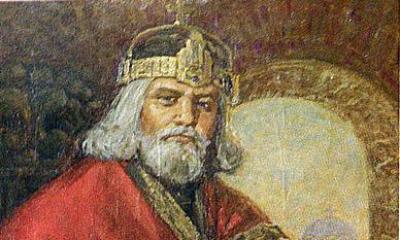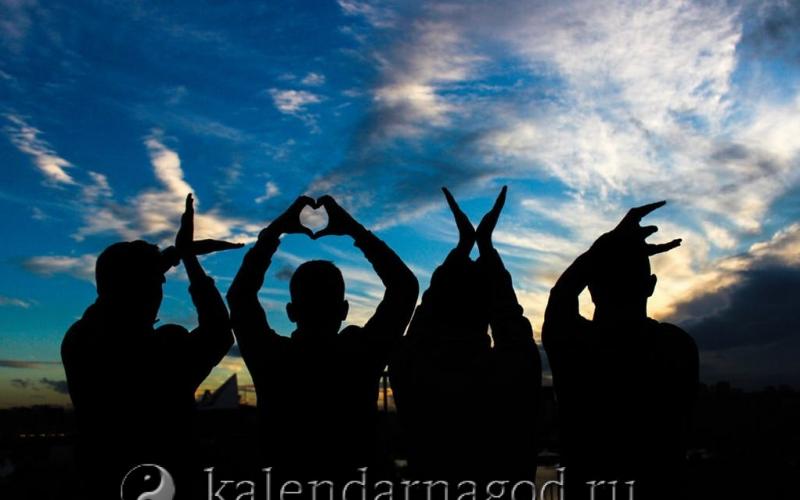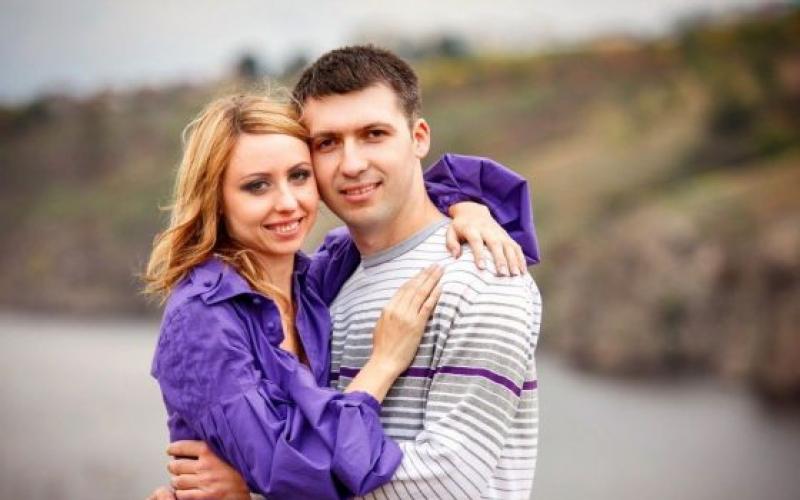The coat of arms of the state is one of its symbols. Every detail on it has its own meaning. On the coat of arms Russian Empire was depicted three crowns: one in the center, the other two - on the heads of an eagle. Do you know what these three crowns symbolized? Let's answer this question.
What did the three crowns symbolize on the coat of arms of the Russian Empire?
There are several explanations for this fact. Let's consider them all.
1 .The crown in the center is a symbol of the power of God, two crowns on the heads of the ora are the unity of royal and spiritual power in Russia.
2. Three crowns appeared on the coat of arms as a sign of the accession to Russia of the three khanates of the disintegrated Golden Horde: Astrakhan, Kazan and Siberia. This demonstrated the power of the state to the whole world.
The history of the Mongol-Tatar yoke goes back more than 250 years: in 1236, Batu Khan ravaged northeastern Russia, and in 1480, after the troops of Ivan III and Khan Akhmat stood on the Ugra River. Russia freed itself from the yoke. Ivan the Terrible annexed almost the entire territory of this once powerful state - the Golden Horde.
Chronology of the annexation of khanates to Russia:
- 1552 - the Kazan Khanate was annexed
- 1556 - Astrakhan Khanate
- 80-90s of the 16th century - the Siberian Khanate as a result of Yermak's campaign.
3. Three crowns denoted the unity of Great Russia (Russia), Little Russia (Ukraine), White Russia (Belarus)
As you can see, the values all correspond to the facts historical development Russia. Each epoch put its meaning into these symbols.
4 .On the coat of arms modern Russia three crowns are also depicted, but their meaning is completely different: they symbolize sovereignty as a whole Russian Federation, and its parts - subjects.
From the history
- The coat of arms of Russia with the image of a double-headed eagle is first found on the seal of Ivan III in 1497, and the coat of arms of the Russian Empire was finally formed in 1882.
- From 1918-1992, there was a coat of arms of the USSR, symbolizing the friendship of 15 republics within the USSR.
- The coat of arms of the Russian Federation was approved by Decree of the President of the Russian Federation on November 30, 1993.
The history of the coat of arms of Russia is very interesting. Over time, I will definitely prepare an article on this topic, as well as on all the symbols of our country. Follow the publications.
Material prepared: Melnikova Vera Aleksandrovna
Russia is unique, among other things, in that over the centuries it has managed to unite in one state the most diverse peoples - each with its own culture, faith and language. Thanks to this, many peoples were not only able to survive as a separate ethnic group, but also were able to further develop their original culture.
A book about the friendship of peoples in single state must appear as soon as possible. The whole current political environment is vehemently demanding it. However, in this moment there is no such book, or it is so deeply hidden that it cannot be found.
In search of such a book, this publication was born. I tried to make a very rough sketch of the history of the unification of peoples in one Russian state. To begin with, I just wanted to mark on the time scale when this or that nation joined, and also to find out, at least superficially, the reasons for such joining, and finally, - calculate the time spent living together in one state.
The structure of the publication was suggested to me by the Great Emblem of the Russian Empire. I recently stumbled upon it by chance and suddenly discovered that in it, in the form of a kind of map, the very story that I am looking for is encrypted!
Great coat of arms of the Russian Empire
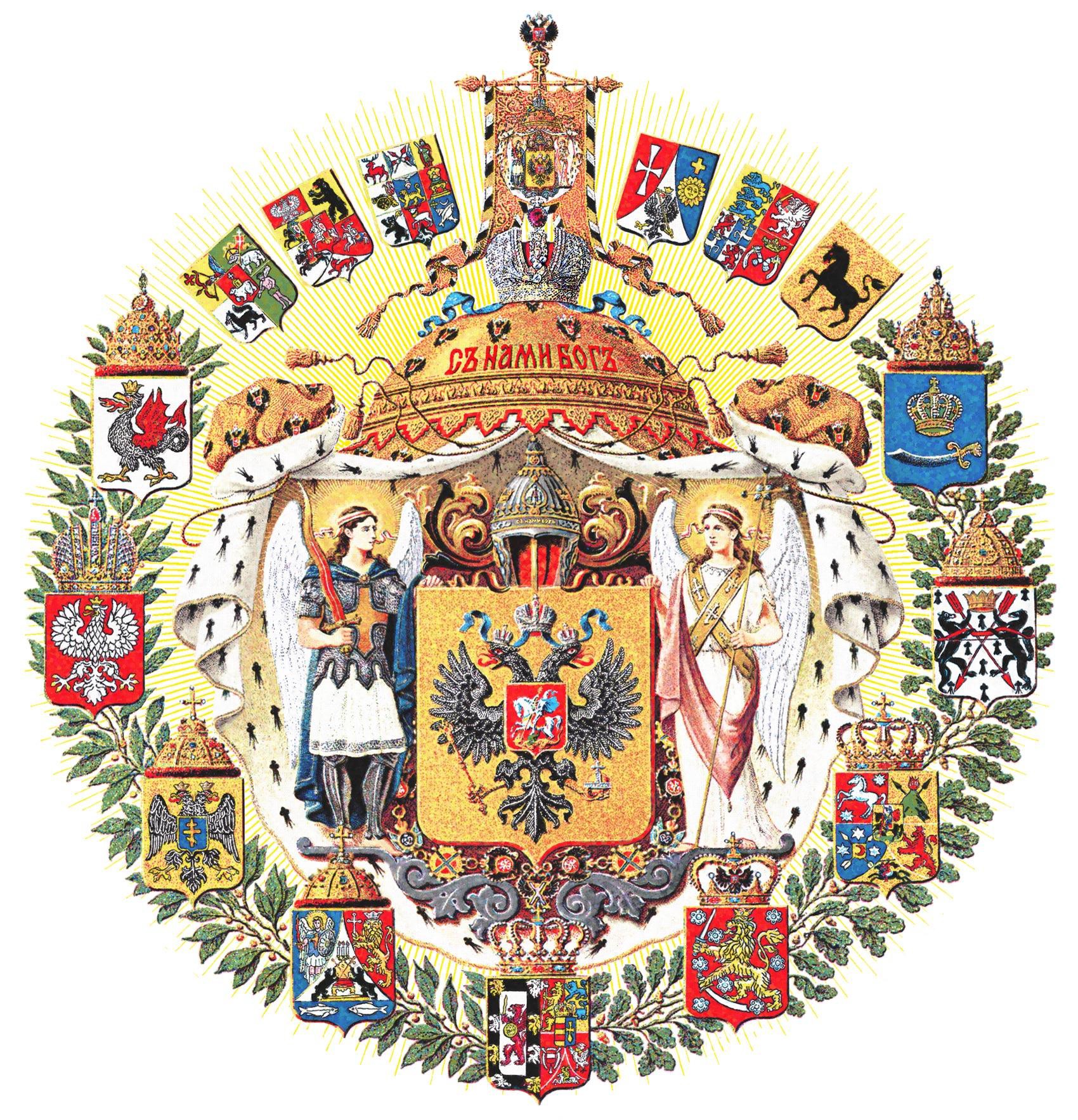
Briefly - about the history of the coat of arms. In Russia, there never existed the concept of a knightly hereditary coat of arms, widely accepted in Western Europe. During the battles, battle banners with embroidered or painted images were carried over the army Orthodox cross or saints. The history of the coat of arms of Russia is, first of all, the history of the Grand Duke's press.
Ivan III the Great (1440-1505) eliminated the dependence of Russia on the Golden Horde and united around Moscow many of the original Russian territories, fragmented since the 12th century. To increase his authority in the eyes of foreign states, Ivan III married Princess Sophia Paleolog, the niece of the last emperor of Byzantium, and adopted the family coat of arms of the Byzantine kings - a double-headed eagle. Since then, the double-headed eagle has been the state emblem on the seals of Russian rulers.
A little later, the image of the Moscow coat of arms was added to the emblem: a horseman slaying a dragon with a spear. This rider was placed first on reverse side seal, and then migrated to the chest of an eagle. Then, first, the coats of arms of the kingdoms of Astrakhan, Kazan and Siberia, conquered by Ivan IV the Terrible (1530 - 1584), were attached to the Moscow coat of arms, and then the coats of arms of all the main regions and lands that became part of the empire in the subsequent time. Thus, the state emblem became the emblem of its entire territory.
Manifesto of Paul I
The idea of the Great State Emblem, as we know it today, was originally proposed by Paul I (1754-1801), the son of Catherine II. In 1800, he published a manifesto on the "Complete State Emblem of the All-Russian Empire" with a detailed description of all parts of the coat of arms. In particular, this is what he writes:
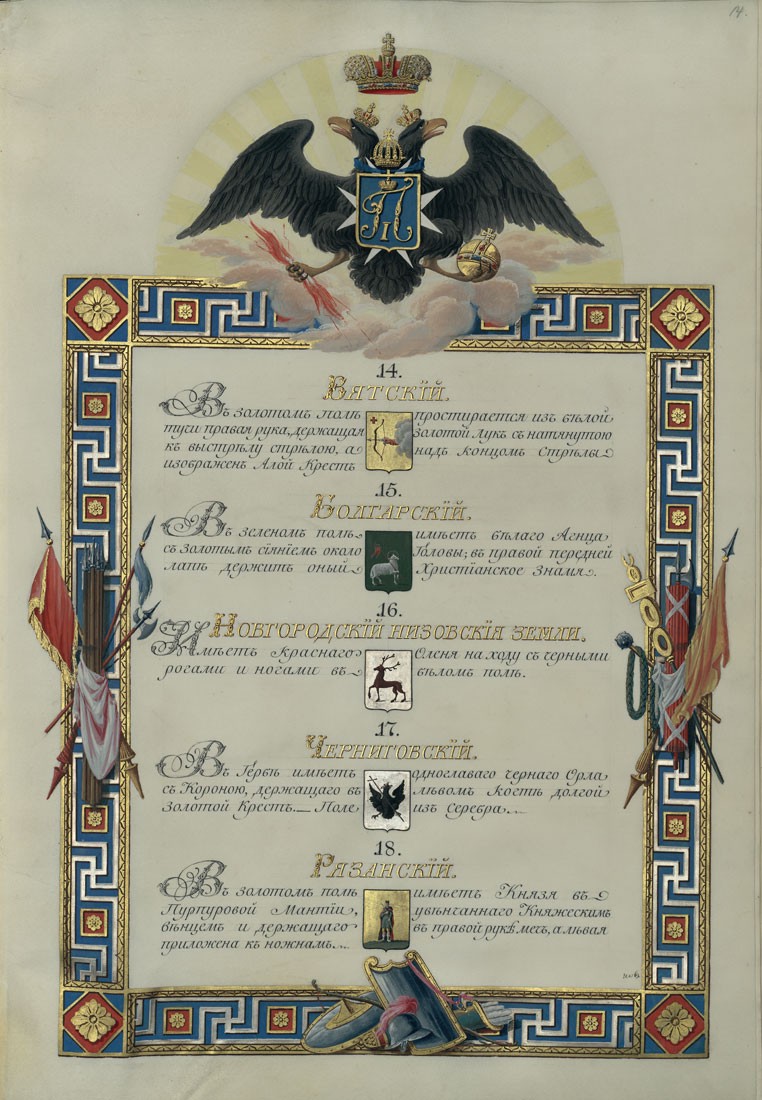
One of the sheets of the manifesto of Paul I on the full coat of arms of the Russian Empire: a sheet with a list of coats of arms of the lands that are part of Russia.
“The current Russian Imperial Coat of Arms was assigned to our Empire in the fifth for ten centuries from now to our days by the providence of God the fate of the Kingdoms that determines, at different times different Powers and lands were attached to the Throne of Russia, whose names are included in our Imperial Title; but the coat of arms of Russia and the State seal have hitherto remained in their former form, disproportionate to the space of our possessions. Now we deign to include in the Russian Coat of Arms, in accordance with our full Title, all the Coats of Arms and signs of the Kingdoms and lands we possess, and therefore, affirming them in the form attached to this, we command the Senate to make their order appropriate in discussing the use of them.
sovereign title
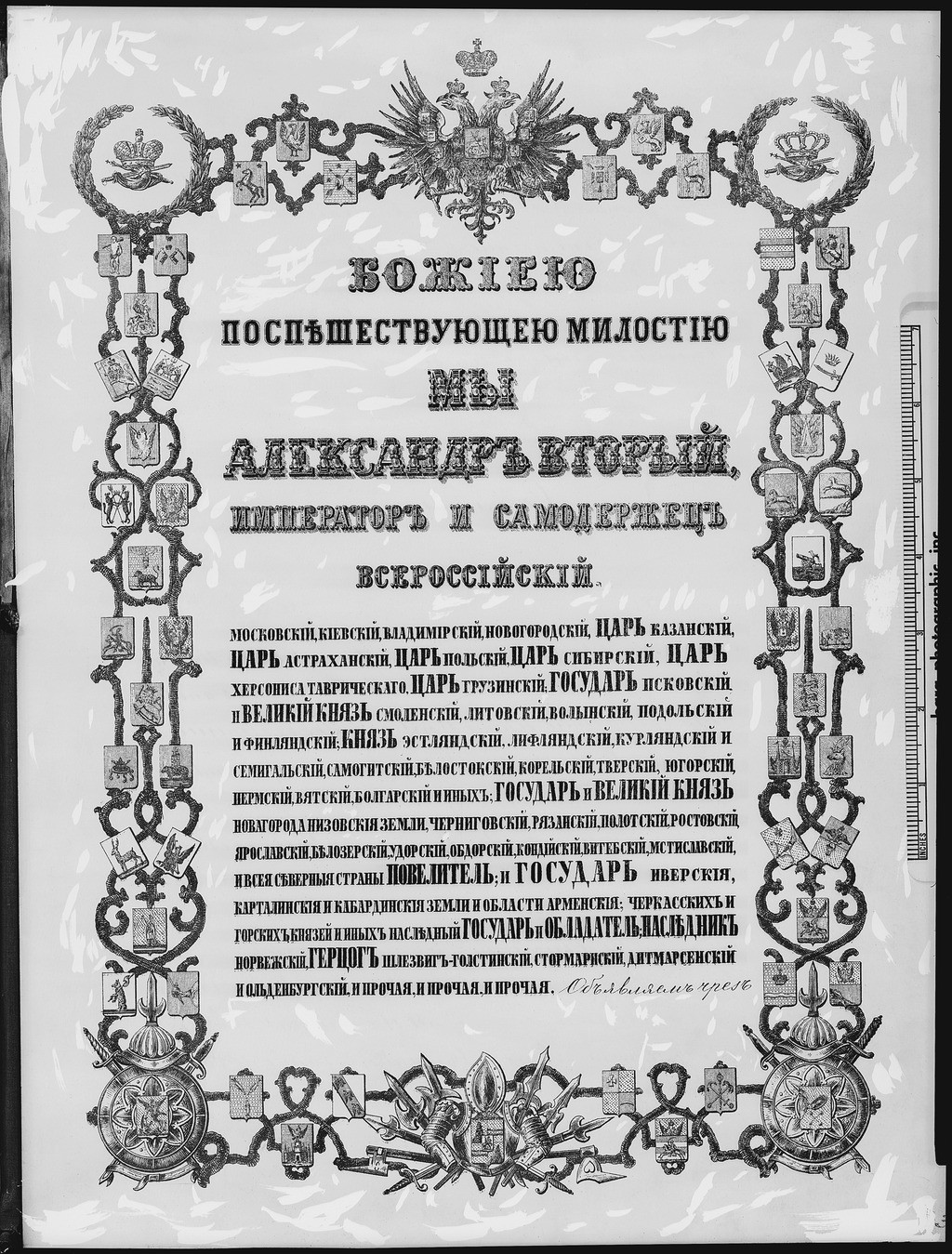
Full title of Alexander II. As you can see, for different lands he can be king, sovereign, grand duke, prince, heir, duke.
Here it is important to pay attention to such a concept as the “imperial title”, which Paul I speaks about several times. The title in general is an honorary hereditary title in class societies (baron, count, prince). Sovereign's title - this is the most important title, the honorary title of the ruler Russian state. This title from the time of Ivan III was supposed to include a listing of all subject lands. This principle of title was preserved by the descendants and was filled with new content in the process of gain or loss of land. Over time, the title more and more turned into a modified, mobile formulation, with the help of which both large-scale and current political tasks were solved. The history of the sovereign's title is the history of the expansion of the territory of the state. When adding a new territory, the sovereign added to his title the title of the former ruler of this territory.
Heraldic reform
Unfortunately, Paul I was killed (not without the participation, by the way, of British intelligence), and he did not have time to bring his manifesto to life. His idea begins to embody his son, Nicholas I (1796-1855). He starts a heraldic reform, inviting Baron B. Kene for this. Again, due to death, Nicholas I did not have time to complete the reform, and his son Alexander II (1818-1881) finished the job. In 1857, the Great State Emblem was “highly affirmed”.
This coat of arms in its original form existed until 1917. Only in 1882 Alexander III(1845-1894) made a slight amendment to the coat of arms: in addition to purely stylistic and compositional changes, a shield was added with the coat of arms of Turkestan, which became part of Russia in 1867.
What is shown on the coat of arms
Drive detailed description we will not leave the entire emblem, so as not to deviate from our main topic, we will only say that the main shield with the emblem of Moscow is surrounded by shields with the emblems of kingdoms, principalities and regions, in different time attached to Russia.
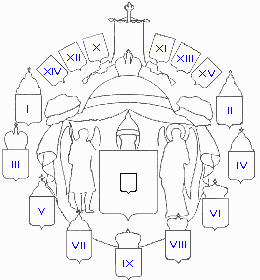
The main shield is surrounded by nine shields from below. Coats of arms of kingdoms: I. Kazansky, II. Astrakhan, III. Polish, IV. Siberian v. Chersonese Tauride, VI. Georgian. VII. United coats of arms of the great principalities: Kiev, Vladimirsky And Novgorod. VIII. Coat of arms of the Grand Duchy Finnish. IX. The family coat of arms of His Imperial Majesty.
There are six shields above the main shield. X. Shield of the united coats of arms of the principalities and regions of the Great Russian. XI. Shield of the united coats of arms, principalities and areas of the southwestern. XII. Shield of the united coats of arms of principalities and regions of Belarusian and Lithuanian. XIII. Shield of United Coats of Arms regions of the Baltic. XIV. Shield of United Coats of Arms northeastern regions. XV. Coat of arms Turkestan.
It turns out that the state emblem is a kind of map that reflects both the political structure of Russia and its geography. Let's try to figure out what historical event is associated with each of the armorial shields, we will supplement the “map” given to us with historical content. In brackets, next to the name of the shield, we will indicate the number corresponding to the number of this shield in the diagram above.
United coats of arms of the Grand Duchies (VII)
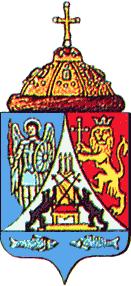
Coat of arms Kyiv ( Saint Michael)
Vladimirsky ( lion leopard),
Novgorod ( two bears and fish).
These are the three most "root" old Russian grand principalities. The Kyiv coat of arms symbolizes the ancestral home of the Russian state Kievan Rus (formed in the middle of the 9th century). Also, Kyiv denotes the south-western Russia formed a little later, the Vladimir coat of arms - north-eastern Russia, and Novogorodsky - north-western (Novgorod Republic). All three Russias were formed in the XII century as a result of fragmentation Kievan Rus and the Tatar-Mongol invasion.
The titles of all the rulers of Russia, starting with Ivan III, always began with a listing of these three lands: “Emperor and Autocrat of All Russia, Moscow, Kyiv, Vladimir, Novgorod ...” - this is how the title of the last Russian emperor Nicholas II began. Then followed all the other kingdoms, principalities and regions.
The history of Russia as a whole, starting with Kievan Rus, has more than 1000 years. Conventionally, all three Russ formed in the 12th century in connection with the collapse of Kievan Rus (before that, they had been together for 300 years). Under the influence of the Tatar invasion in the XIII century until the middle of the XV century they were separated (200 years), but since then they have been together again (more than 500 years). It will be interesting further to compare with these time intervals the time of the joint life of other peoples, gradually joining Russia.
Coats of arms of Great Russian principalities and regions (X)
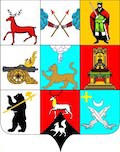
Coat of arms Pskov ( golden leopard in the center) , coat of arms Smolensky ( a gun) , coat of arms Tverskoy ( golden throne) , coat of arms Yugorsky ( hands with spears) , coat of arms Nizhny Novgorod ( deer), coat of arms Ryazan ( standing prince) , coat of arms Rostov ( silver deer) , coat of arms Yaroslavsky ( bear) , coat of arms Belozersky ( silver fish) , coat of arms Udorsky ( fox).
As a result of the ensuing war with the Commonwealth, Russia returned the lands lost as a result of the Time of Troubles. And Alexei Mikhailovich (1629-1676) supplemented the title with a new wording: "Sovereign, Tsar and Grand Duke of All Great and Small and White Russia Autocrat."
The territory of present-day central Ukraine was part of Russia/USSR from the middle of the 17th century to the end of the 20th (together for more than 300 years).
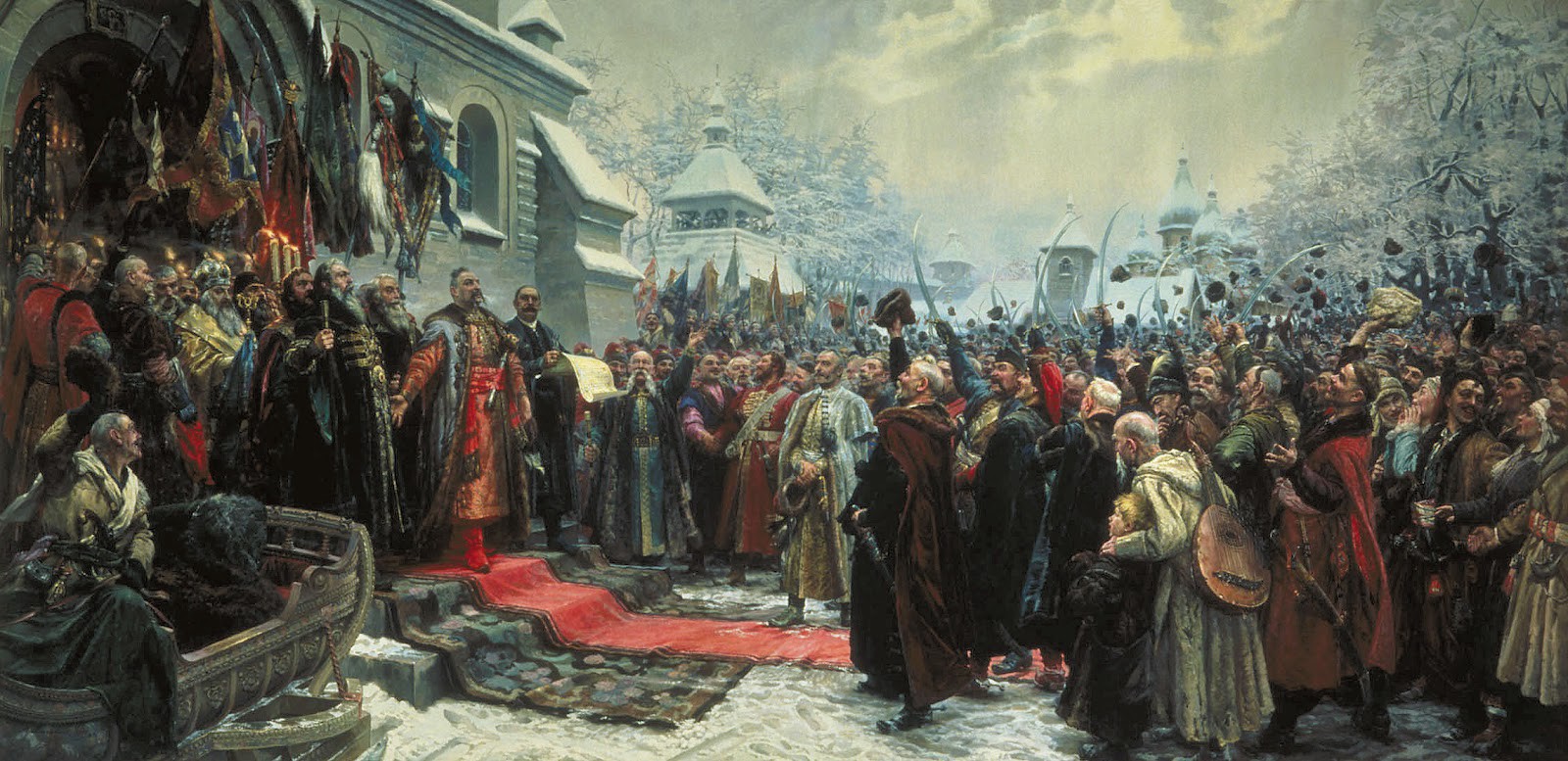
In 1654, the scepter and orb first appeared on the royal seal in the paws of an eagle. Forged double-headed eagle mounted on the spire of the Spasskaya Tower of the Moscow Kremlin. In 1667, Alexei Mikhailovich, in the first ever decree on the coat of arms (“On the royal title and on the state seal”), gave an official explanation of the symbolism of the three crowns over the heads of the eagle:
“The double-headed eagle is the coat of arms of the sovereign Grand Sovereign, Tsar and Grand Duke Alexei Mikhailovich of All Great and Small and White Russia, the autocrat, His Tsarist Majesty of the Russian reign, on which three crowns are depicted signifying the three great Kazan, Astrakhan, Siberian glorious kingdoms. On the Persians (chest) the image of the heir; in pasnoktyah (claws) a scepter and an apple, and reveals the most merciful Sovereign, His Royal Majesty the Autocrat and Possessor.
More than 100 years later, in 1793, under Catherine II, as a result of the second partition of the Commonwealth, Podolsk and Volyn, along with the entire right-bank Ukraine, were ceded to Russia.
The territory of the current western, right-bank, Ukraine as part of Russia / CCCP since the end of the 18th century (together 200 years).
A significant part of modern Ukraine in the middle of the XIV century was included in the Grand Duchy of Lithuania, and from the middle 16th century - c the composition of the Commonwealth (i.e., before reunification with Russia, central Ukraine was Lithuanian for 200 years and Polish for another 100 years, and western Ukraine was Lithuanian for 200 years and Polish for another 200 years).
For the first time, Ukraine acquires a formally independent statehood, becoming a Soviet republic within the USSR. At the same time, the territory of modern Ukraine was formed. And the first sovereign state Ukraine forms in 1991 as a result of the collapse of the USSR. Those. This state is just over 20 years old.
Coats of arms of the Baltic regions (XIII)
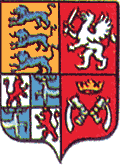
Coat of arms Estonian ( three leopard lions) Livonian ( silver vulture with sword) , emblems - Courland ( lion) and Semigalsky ( deer) , coat of arms Karelian ( hands with swords).
Peter I (1672-1725) cut a window to Europe. In 1721, according to the Treaty of Nystadt, Estonia (today's server Estonia), Livonia (today's northern Latvia and southern Estonia) and Karelia passed from Sweden to Russia. Accordingly, at that time the title of sovereigns included: "Prince of Livonia, Estland and Karelia." And the phrase of the big title "Great Sovereign, Tsar of All Great and Small and White Russia, Autocrat" changes to "We, Peter the Great, Emperor and Autocrat of All Russia."
On the coat of arms near the eagle, instead of royal crowns, imperial crowns appear, on his chest appears the order chain of the Holy Apostle Andrew the First-Called, the patron saint of Russia and heavenly patron the king himself. On the wings of an eagle for the first time appear shields with the coats of arms of the Great Kingdoms and Principalities. On the right wing there are shields with coats of arms: Kiev, Novgorod, Astrakhan; on the left wing: Vladimir, Kazan, Siberian.
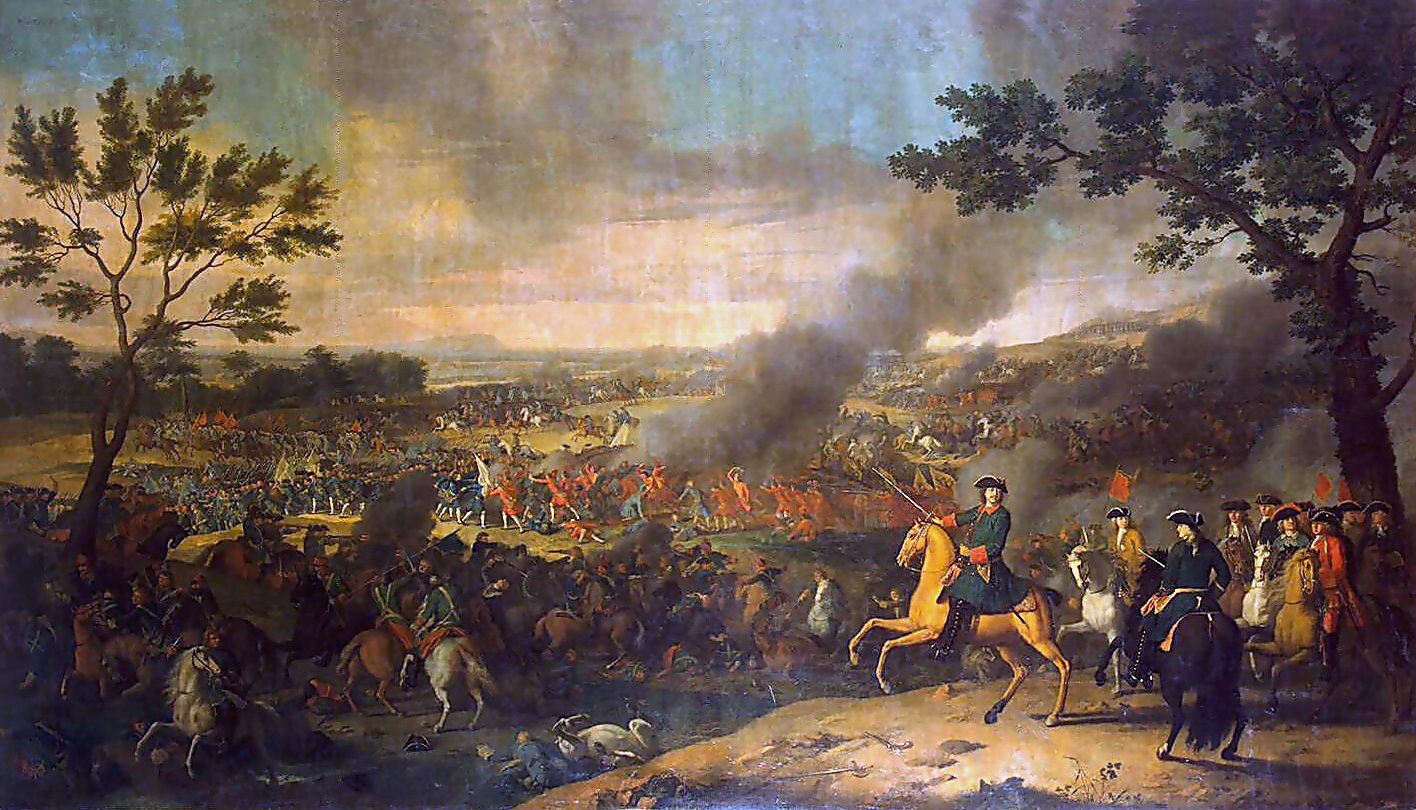
"Poltava battle". Louis Caravaque. 1717–1719
In 1795, under Catherine II, as a result, Courland and Semigallia (present-day western Latvia) were ceded to Russia. Catherine II adds "princess of Courland and Semigalle" to the title.
So. From the 13th to the 16th centuries (300 years), the peoples of present-day Estonia and Latvia were under the control of the Germans as part of the Livonian Order. According to the resultsLivonian War from the end of the 16th century to the beginning of the 18th century (more than 100 more years), the territory of Estonia was part of Sweden, and the territory of Latvia was divided between Sweden and the Commonwealth.
From the beginning of the 18th to the beginning of the 20th centuries, Estonia and Latvia were part of the Russian Empire (200 years), and from the middle to the end of the 20th century they were part of the USSR (another 50 years).
For the first time in their centuries-old history, Estonia and Latvia became independent states in 1918 as a result of the collapse of the Russian Empire. And in 1940 entered to the USSR in connection with the threat of an attack by Nazi Germany. Estonia and Latvia regained their independence in 1991 due to the collapse of the USSR. Thus, the total history of sovereignty among these peoples is about 50 years old.
Coats of arms of Belarusian and Lithuanian principalities and regions (XII)
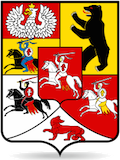
Coat of arms of the Grand Duchy Lithuanian ( silver rider - in the center) , coat of arms Bialystok ( eagle rider) , coat of arms Samogitsky ( bear) , coat of arms Polotsk ( rider on a white background) , coat of arms Vitebsk ( rider on a red background) , coat of arms Mstislavsky ( Wolf).
In 1772, under Catherine II, as a result of the first partition of the Commonwealth, Belarusian lands, including Polotsk, Vitebsk and Mstislavl, were ceded to Russia. In 1795, as a result of the third partition of the Commonwealth, the Grand Duchy of Lithuania ceded to Russia. In 1807, under Alexander I, according to the Treaty of Tilsit, Bialystok (Belarus) and Samogitia (Lithuania) were ceded to Russia.
It turns out that today's Belarus and Lithuania lived together with Russia/USSR for 200 years. Prior to that, Belarus was part of the Grand Duchy of Lithuania. And the Grand Duchy of Lithuania itself was formed in the XIII century. 300 years later, in the middle of the 16th century, it formed the Commonwealth state with Poland and stayed with it until joining Russia for almost 250 years. The history of Lithuanian independence spans over 500 years.
Belarus for the first time gained formal independence within the USSR. And it gained full independence for the first time in 1991 as a result of the collapse of the USSR. This state is just over 20 years old, like Ukraine.
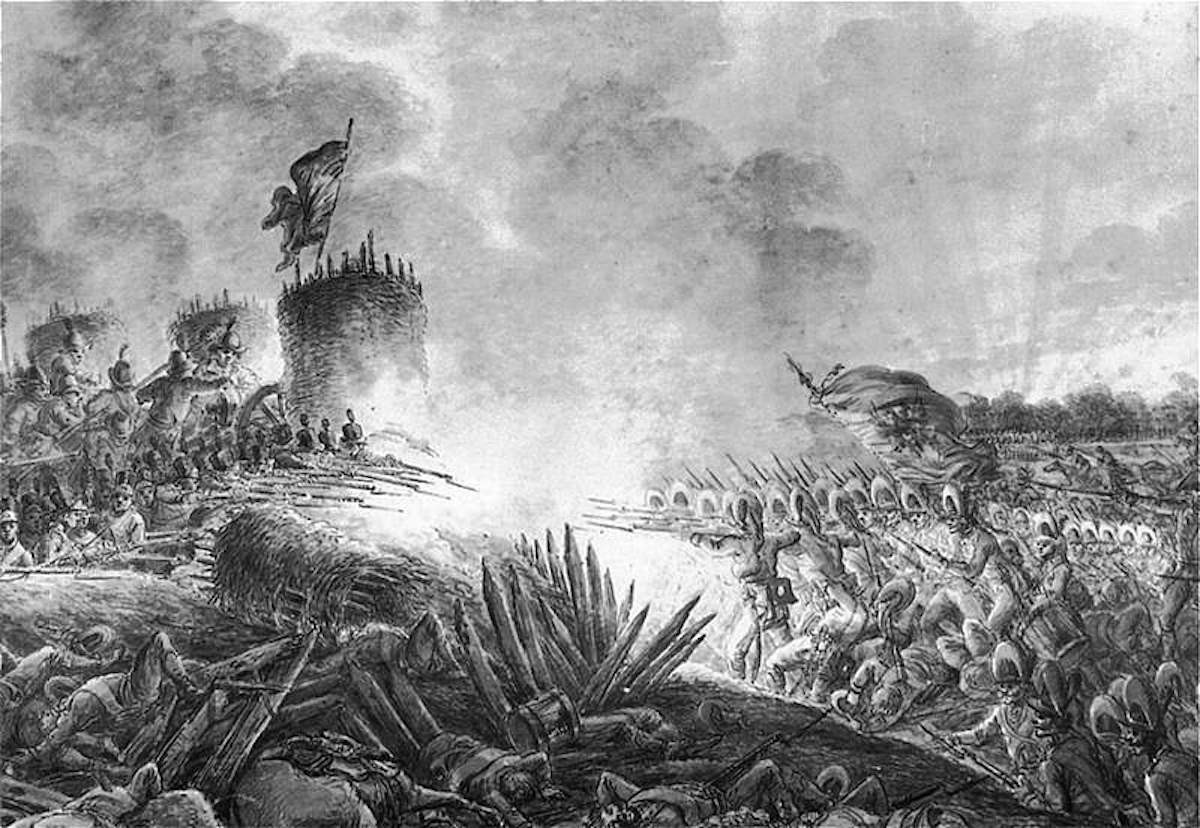
"Storm of Prague" (1797). Alexander Orlovsky. The assault was commanded by General-in-Chief Suvorov and received the highest military rank of field marshal for this victory. The storming of Prague ended the suppression of the Polish uprising of 1794.
Coat of arms of Chersonese Tauride (V)
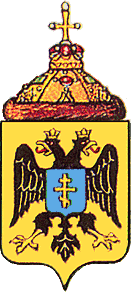
Coat of arms of Chersonese Tauride
As a result of the Russian-Turkish war of 1768-1774, according to the Kyuchuk-Kaynardzhi peace treaty, under Catherine II, Novorossia and the North Caucasus went to Russia, and the Crimean Khanate came under its protectorate.
And already in 1783, Catherine II (1729-1796) issued a manifesto, according to which the Crimea, Taman and Kuban became Russian possessions. Thus, the Crimea finally became part of the Russian Empire. And Catherine II added to the sovereign title: "Queen of Tauric Chersonesus."
Crimea, North Caucasus and Novorossiya as part of Russia for 200 years.
The modern history of Crimea begins in the middle of the 15th century with the formation on its territory from a fragment of the Golden HordeCrimean Khanate , which quickly became a vassal of the Ottoman Empire (it turns out that Crimea was part of the Khanate for 300 years).
Coat of arms of the Grand Duchy of Finland (VIII)
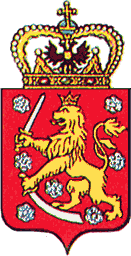
Coat of arms of the Grand Duchy of Finland
As a result of the war with Sweden, under the Friedrichsham Peace Treaty in 1809, the lands of Finland passed from Sweden to Russia on the rights of a union. Alexander I (1777-1825) adds the title "Grand Duke of Finland" to the sovereign.
The territory of present-day Finland, for most of its history, from the 12th century to the beginning of the 19th century (600 years), was part of Sweden. After that, it became part of Russia as the Grand Duchy of Finland, having existed in this form until the collapse of the Russian Empire at the beginning of the 20th century (they were together for 100 years). For the first time, Finland gained an independent statehood in 1917. Those. This state is less than 100 years old.
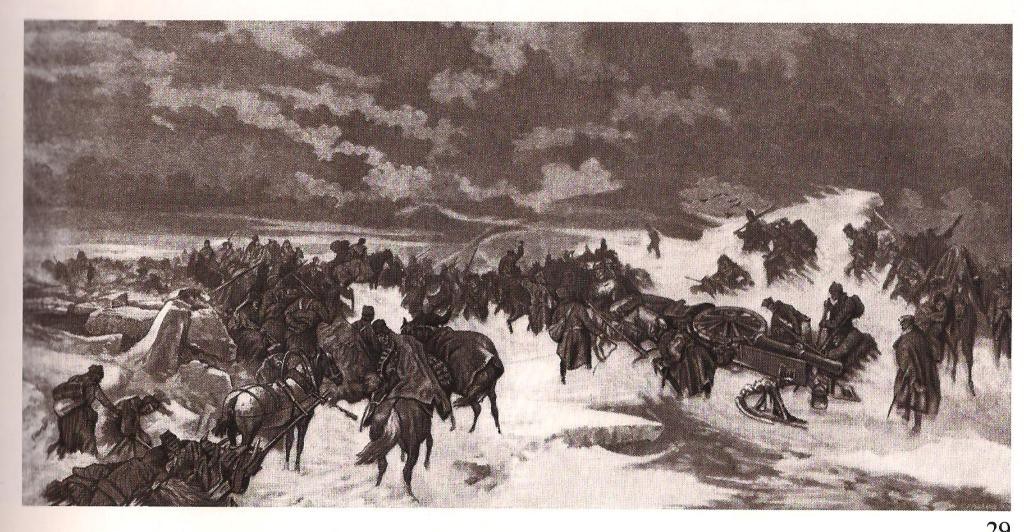
"Transition of Russian troops through the Gulf of Bothnia in March 1809"
Woodcut by L. Veselovsky, K. Kryzhanovsky after the original by A. Kotzebue, 1870s.
Coat of arms of the Kingdom of Poland (III)
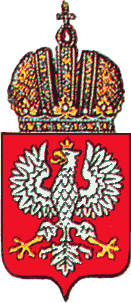
Coat of arms of the Kingdom of Poland
After the final defeat of Napoleon, according to the results of the Congress of Vienna in 1815, the former lands of Poland, which at that moment were under the protectorate of France, went to Russia and formed a union with it as the Kingdom of Poland. Alexander I adds to the sovereign title: "Tsar of Poland". After the coronation of Nicholas I to the Kingdom of Poland in 1829, since 1832, the coat of arms of this kingdom first appears on the wings of an eagle.
Poland was formed as an independent state parallel to Kievan Rus, in the 9th century. In the middle of the 16th century, Poland united with the Grand Duchy of Lithuania to form the Commonwealth, which existed until the end of the 18th century. Then the state completely disappeared, being divided among neighboring states, including Russia. And from the beginning of the 19th century, Poland was revived as the Kingdom of Poland within Russia and existed in this form until the beginning of the 20th century and the collapse of the Russian Empire (100 years together). Before joining Russia, Poland had 900 years of independent history.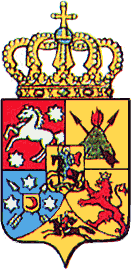
Trying to protect the country from the raids of Turkey and Iran, the Georgian kings repeatedly asked Russia for patronage. In 1783, under Catherine II, the Treaty of Georgievsky was concluded. Its essence was reduced to the establishment of a protectorate by Russia. In 1800, the Georgian side asked for closer cooperation. And Paul I (1754-1801) issued a manifesto according to which Georgia joined Russia as an independent kingdom. But already in 1801, Alexander I issued a new manifesto, according to which Georgia was directly subordinate to the Russian emperor. Accordingly, Paul I adds to the title: "Sovereign of the Iversky, Kartalinsky, Georgian and Kabardian lands." And Alexander I adds to the title already: "King of Georgia."
The formation of Georgia as a state dates back to the 10th century. From the 13th to the 14th centuries, the state was first invaded by the Mongols, and then by Tamerlane. From XV to XVII Georgia is torn apart by Iran and the Ottoman Empire, turning into an isolated Christian country, surrounded on all sides by the Muslim world. From the end of the 18th century to the end of the 20th century, Georgia was part of Russia/USSR (200 years together). Before that, it turns out that Georgia has an 800-year history of a separate state.
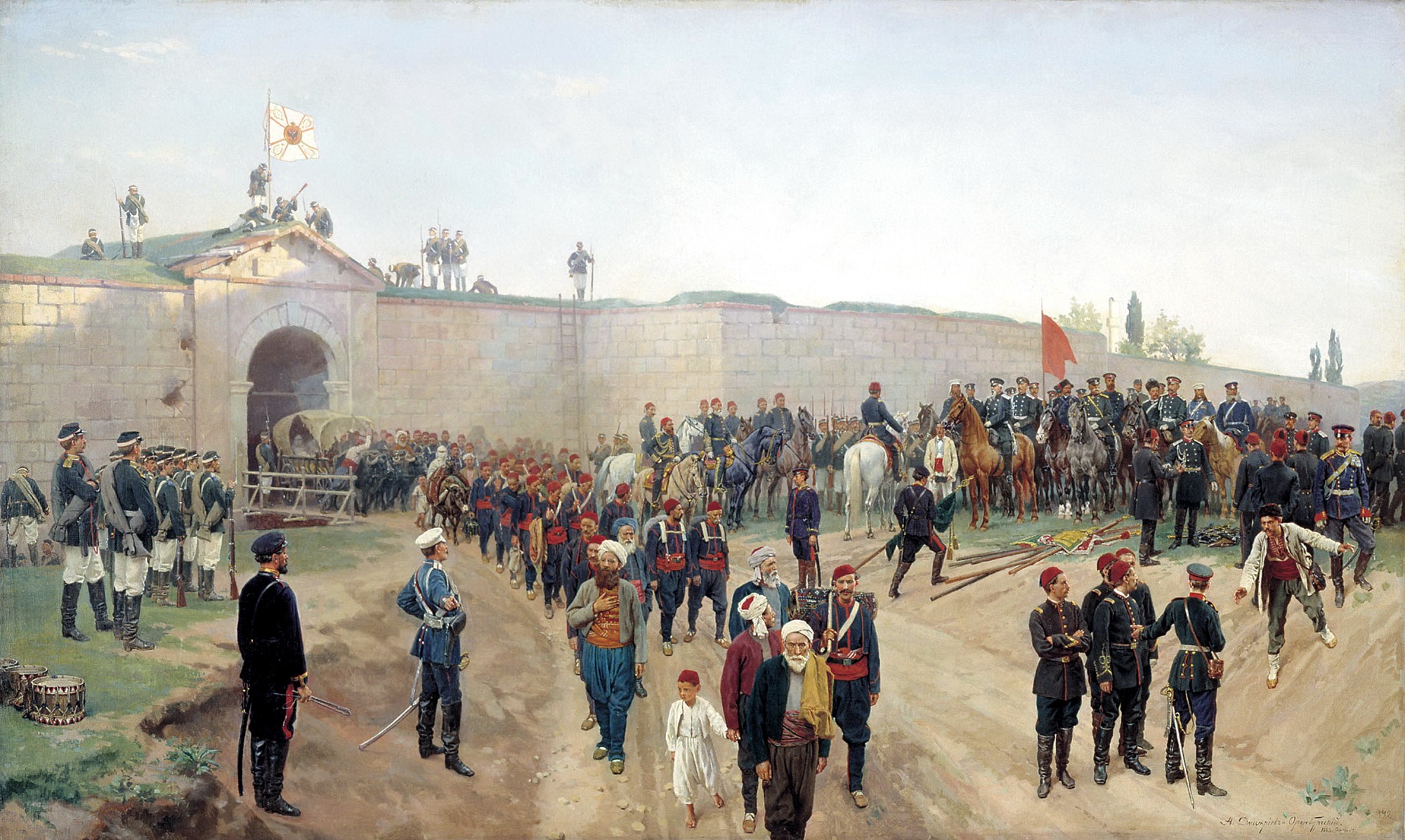
The conquest of Transcaucasia by Russia was completed in the first years of the reign of Nicholas I. As a result of the Russian-Persian war of 1826-1828, the Erivan and Nakhichevan khanates were annexed to Russia, which united into the Armenian region, where about 30 thousand Armenians moved from Persia. As a result of the Russian-Turkish war of 1828-1829, the Ottoman Empire also recognized Russia's power over Transcaucasia, and about 25 thousand Armenians moved to Russia from its territory. As a result of the Russian-Turkish war of 1877-1878, Russia annexed the Kars region, inhabited by Armenians and Georgians, and occupied the strategically important Batumi region. Alexander II (1855-1881) adds to the title: "Sovereign of the Armenian region." The annexation of Turkestan was preceded by the annexation of the Kazakh Khanate (present-day Kazakhstan). The Kazakh Khanate was formed from a fragment of the Golden Horde in the 15th century, and in the 19th century it consisted of three parts: the Younger (west), Middle (center) and Senior (east) zhuzes. In 1731, under the protectorate of Russia - for protection from the Khiva and Bukhara khanates - the Younger zhuz was asked and accepted. In 1740, the Middle Zhuz was adopted under the protectorate to protect against the Kokand Khanate. In 1818 - a part of the Great Zhuz. And in 1822 the power of the Kazakh khans was abolished. Thus, Kazakhstan has been together with Russia for more than 250 years.
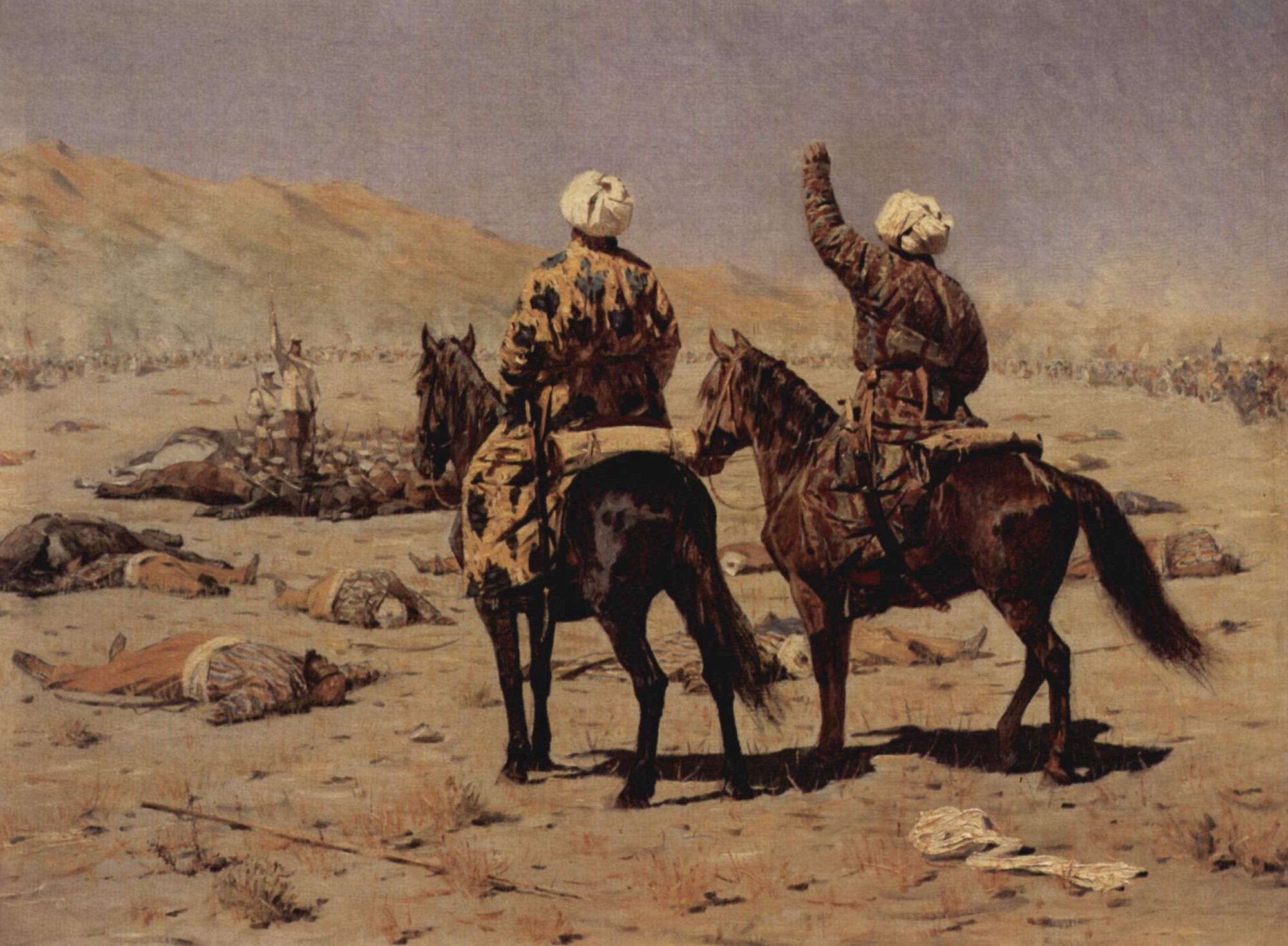
"Parliamenters". Artist Vasily Vereshchagin
In 1839, Russia begins the fight against the Kokand Khanate. One of the most important reasons was opposition to the aggressive policy of the British Empire in Central Asia. This confrontation was called "The Great Game". In the 50s and 60s many Kokand cities were taken, and in 1865 Tashkent was taken and the Turkestan region was formed. In 1867, Emperor Alexander III (1845-1894) approved a project on the formation of a new governor-general - Turkestan Territory. This marked the completion of the initial stage of the annexation of the Central Asian territories. Alexander III begins to be titled "Sovereign of Turkestan".
Formulated like this:
"By God's hastening mercy We ( name) , Emperor and Autocrat All-Russian, Moscow, Kyiv, Vladimir, Novgorod;Tsar Kazansky,Tsar Astrakhan,Tsar Polish,Tsar Siberian,Tsar Chersonis Tauride,Tsar Georgian;Sovereign Pskov andGrand Duke Smolensk, Lithuanian, Volyn, Podolsky and Finnish;Prince Estonian, Livonian, Courland and Semigalsky, Samogitsky, Bialystok, Korelsky, Tver, Yugorsky, Perm, Vyatsky, Bulgarian and others;Sovereign and Grand Duke Novgorod Nizovsky lands, Chernigov, Ryazan, Polotsk, Rostov, Yaroslavl, Belozersky, Udorsky, Obdorsky, Kondia, Vitebsk, Mstislav and all northern countrieslord and sovereign Iver, Kartalinsky and Kabardian lands and regions of Armenia; Cherkasy and Mountain princes and othershereditary Sovereign and Possessor ; Sovereign Turkestan,Heir Norwegian,duke Schleswig-Holstein, Stornmarn, Dietmar and Oldenburg and others, and others, and others.
The first information about the Swedish state dates back to the VIII-IX centuries. Ancient chronicles spoke of the kingdom of the Swedes with its capital in the city of Birka (near modern Uppsala), which arose in the eastern part of Central Sweden. Over time, the power of the Swedes extended to most of southern Sweden.
Svei settlements that arose on the southeast coast Baltic Sea, became bases for the Vikings, who organized joint raids on Western European settlements with the Danish and Norwegian Vikings from here. However, most of the Swedish warriors and merchants through the Baltic Sea and along the rivers flowing through the territory of the present Baltic states, Belarus, Ukraine and the European part of Russia, went in search of contacts with eastern countries.
In the XI century. The kingdom of the Svei, which included almost the entire territory of modern Sweden with the exception of the southern and western coastal regions, which were under the rule of the Danes until the 17th century, was isolated. The reason for this was the internecine wars of pretenders to the royal throne, which was empty after the death in 1060 of Olaf, the last king of the Swedes.
This period lasted over a hundred years. One of the famous kings who ruled during this period was Erik Jedvarsson (c. 1156-1160), who, according to legend, organized a crusade to Finland and conquered it. On May 18, 1160, King Eric IX the Holy died near Uppsala in a battle with the Danes led by Prince Magnus and was buried in the local cathedral. Already at the end of the XII century. the cult of the king began to take shape and various legends began to arise about him. The king was later canonized and is currently one of the most revered saints in Sweden.
During the reign of the last king of the St. Eric dynasty - Erik Eriksson, the main political figure was his brother-in-law - Jarl Birger, who was struck by Yakov Polochanin, a warrior from Polotsk, during the Battle of the Neva. The son of Jarl Birger, Valdemar, after the death in 1250 of Erik Eriksson, became the first king of the Folkung dynasty.
In 1397, the Danish Queen Margaret united Denmark, Norway and Sweden in the so-called. Kalmar Union. In the same year, at a meeting of representatives of the nobility of Norway, Denmark and Sweden, Eric Pomeransky became king of Norway and Denmark.
Constant strife both within the states of the union and between them led at the beginning of the 16th century. to bitter wars between Denmark and Norway on the one hand, and Sweden and Finland on the other.
In 1520, during the accession to the throne of the Danish king Christian II in Sweden, more than 100 well-known representatives of various classes were executed. In response to this event, called the Stockholm bloodbath, an uprising began in the province of Dalarna, which swept other areas and soon Sweden was freed from the power of the Danish king, and in 1523 the rebel leader Gustav Vasa (1496-1560) was elected king of independent Sweden .
The son of Gustav Vasa, King Eric XIV, decided to seize the lands of the disintegrated Livonian state of the Teutonic Knights, which led in 1563 to a war with Denmark, which had the same plans.
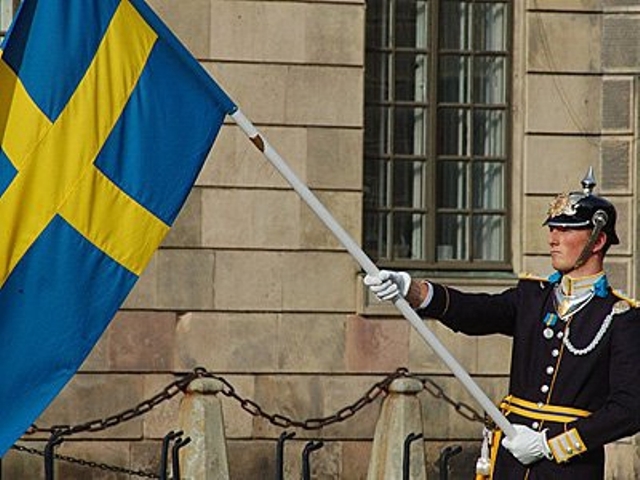
In 1630, under King Gustav II Adolf, Sweden entered the Thirty Years' War on the side of the German Protestants and in 1643-1645. and 1657-1658. defeated Denmark, as a result of which the former Danish provinces of Skane, Halland, Blekinge and Gotland and the Norwegian Bohyuslan, Jämtland and Harjedalen, as well as Finland, a number of provinces in Northern Germany (Pomerania, Bremen), Estonia, Latvia and Ingermanland ceded to Sweden.
According to the Westphalian 1648 and Roskilde 1658 peace treaties with Denmark, Sweden acquired western Pomerania, control over the mouths of the Elbe and Weser rivers, and even founded a colony in North America in what is now the state of Delaware.
However, the almost continuous wars that Sweden has waged since the beginning of the century have exhausted its financial resources, which forced the regents to sell or distribute a significant part of the lands confiscated by Gustav Vasa from the church, as well as to ask for subsidies from other states. In return for the subsidies provided, France demanded that Sweden participate in the war with Brandenburg and Denmark in 1674, as a result of which all Swedish possessions in Germany were captured by opponents. However, Sweden emerged from the war without serious losses, and the 15-year-old Charles XII, who ascended the throne, inherited a strong and influential state.
In 1700, Russia, Saxony, in alliance with the Commonwealth, Denmark and Norway, having formed an offensive alliance, began the Northern War against Sweden. Despite his young age, Charles XII turned out to be a talented commander. He forced Denmark out of the war and defeated Russian army in the battle of Narva, then he turned his troops to the south, put his protege on the throne of Poland and in 1706 forced the Polish king Augustus II to make peace. However, having suffered defeat from the Russian army in the battles of Lesnaya in 1709, on the territory modern Belarus, and the final defeat in the battle of Poltava, on the territory of modern Ukraine, the Swedish army surrendered, and Charles XII fled to Turkey, where for five years he tried to persuade the Sultan to start a war against Russia. Then Karl returned to Sweden, which by this time had lost all its possessions in Germany.
Subsequently, Charles XII undertook two military campaigns in Norway, where he died in 1718 during the siege of the fortress. The throne was inherited by Karl's sister Ulrika Eleonora and her husband Fredrik I (Frederick of Hesse), but at the cost of adopting a constitution that guaranteed the political power of the Riksdag.
The Northern War ended with the conclusion in 1720-1721. a number of peace treaties under which Sweden lost all its overseas possessions, except for Finland and part of Pomerania.
In 1809, after Russia occupied Finland in accordance with the Treaty of Tilsit concluded by Alexander I and Napoleon I, the Riksdag, hoping to return Finland with the help of France, invited Napoleonic Marshal Jean Baptiste Bernadotte to take the Swedish throne. Bernadotte arrived in Sweden in 1810, and in 1812 made an alliance with Russia against France and in 1818 became King Charles XIV Johan.
During World War I, Sweden maintained a policy of neutrality. Also during the war between the USSR and Finland in 1940, Sweden remained neutral, but several thousand Swedish volunteers took part in the fighting on the side of Finland.
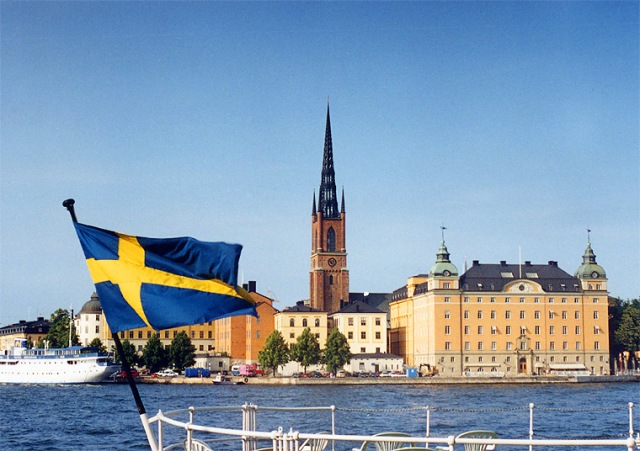
During the Second World War, Sweden was forced to allow the transit of German troops through its territory to Norway. At the same time, Sweden provided assistance to the resistance movement in Denmark and Norway, and the Swedish Red Cross helped rescue many Scandinavian citizens who were in German concentration camps.
Back in 1932, the ruling party in Sweden was the Social Democrats, who announced plans to build a welfare society, which they carried out after the end of the Second World War.
Flag
The legend about the origin of the Swedish flag says that King Eric IX the Holy was a zealous zealot for Christianity and soon after accession to the throne undertook a crusade to convert pagan Finns to Christianity. Before the battle, the king turned to God with a passionate prayer for the grant of victory. On his knees, he looked up and saw a golden cross emanating from the sun in his bright blue. Considering this a good sign, the king ordered to make a banner, on the blue cloth of which a golden cross was depicted.
It is not known what form this banner had, however, in Sweden, both before this event and after it, a blue-and-yellow striped coat of arms was used.
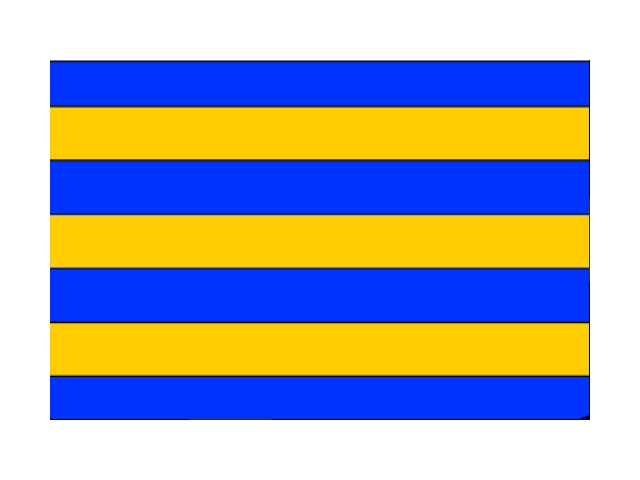
It is also known from the Novgorod chronicles that the ships of the son-in-law of the Swedish king Erik Erikson - Lepse Jarl Birger, who arrived in 1240 at the mouth of the Neva, carried blue flags on the masts with the image of a golden lion with a raised sword, therefore, most likely the blue flag with a golden cross owes its appearance not to Eric IX the Saint, but to later kings. So, there is evidence that the flag with a blue cross was approved by King Albrecht (1363-1387).
The existence of the Swedish flag has been documented since about the middle of the 15th century. Most likely, it was formed from a golden cross located between the four blue fields of the royal coat of arms of Gustav I Vasa (1523-1560). And approved the blue flag with a yellow cross the flag of the kingdom of King Eric XIV (1560-1568). Moreover, it was immediately established that the vertical crossbar of the cross should be closer to the shaft.
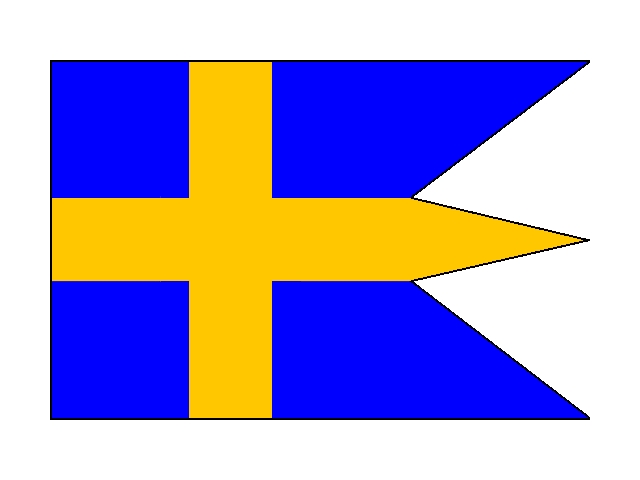
The colors of the flag were explained as follows: yellow is the golden color of the sun, and blue is the sky and the sea.
In 1569, King Johan III established that the golden cross should always be on the Swedish battle colors. But all the ships of Sweden, both military and commercial, sailed under a blue flag with a golden cross, and the flag was of the same shape - with three pigtails. In order to highlight the battle flags, the prescription of 1663 established that the flag with three braids should be flown on all ships, except for merchant ships, for which a rectangular flag was installed.
Thus, the flag with three braids effectively became the naval ensign.
On March 7, 1815, King Charles XIII approved a single naval ensign for Sweden and Norway. They became the Swedish flag with a white St. Andrew's cross in the red first quarter. 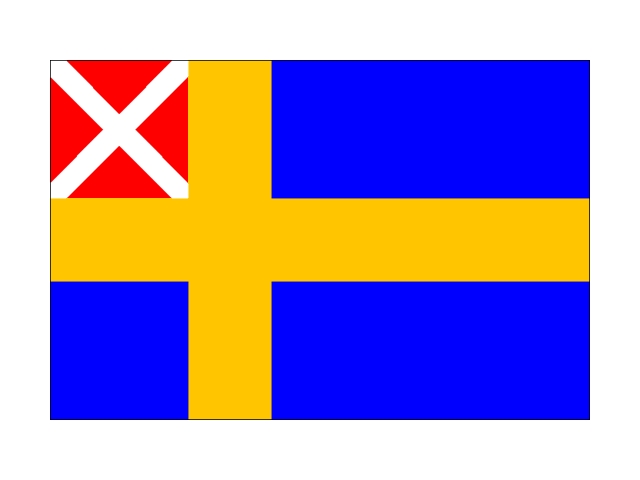
This flag was the naval ensign of Sweden and Norway until 1844. The same but rectangular flag was also raised by Norwegian merchant ships in 1815-1821. and Sweden in 1815-1844.
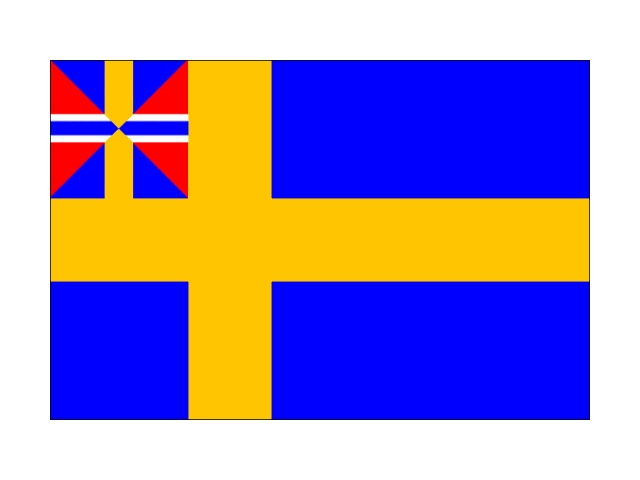
Based on this flag, the flag of the Union was created. merchant fleet, which was approved on October 26, 1818.
In 1844, a new union flag was created - a square divided diagonally into four parts, the upper and lower ones are of Norwegian colors, the right and left are Swedish (1821 model). This image was placed in the first quarter of the Swedish and Norwegian flags (commercial flags were rectangular, naval ones had three pigtails).
In 1898, Norway unilaterally withdrew from the union and removed the union emblem from its flag, but the union symbol was on the Swedish flag until 1906.
On June 22, 1906, after the official liquidation of the Norwegian-Swedish union, the blue flag with a golden cross was legally approved as the flag of Sweden and its proportions were approved: 10: 16, the proportions of the stripes in length 5: 2: 9, in width 4: 2: 4 .
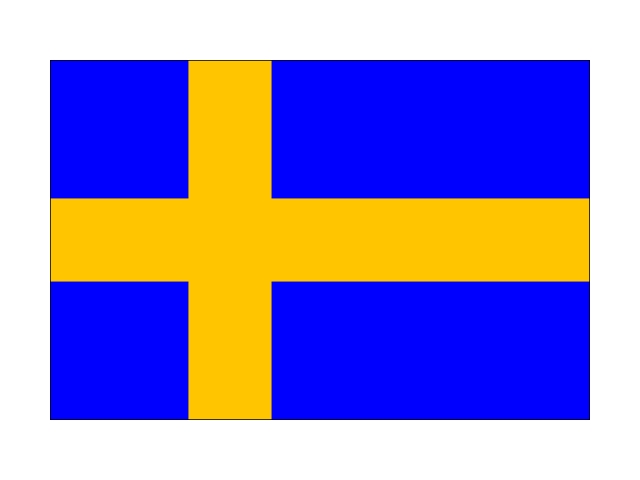
Proportions of the flag with pigtails: length 5:2:5:8 (for braids), width 4:2:4.
With the image of the Great State Emblem on the crosshairs of the cross, this flag is the royal standard.
In 1983, the flag day was approved, which is celebrated on June 6, in memory of the accession to the throne of King Gustav I Vasa. This day is a Swedish national holiday.
Coat of arms
The coat of arms of the king of the Swedes Knut Jahonson (died in 1234) was a blue field with alternating gold, silver and gold belts.
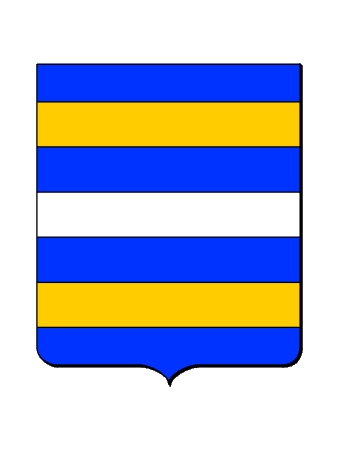
The field of the coat of arms of Magnus Ladulas (1240-1290) was also blue. In it, with three silver wavy bands to the left, was a reared golden crowned lion - the dynastic coat of arms of the Folkungs.
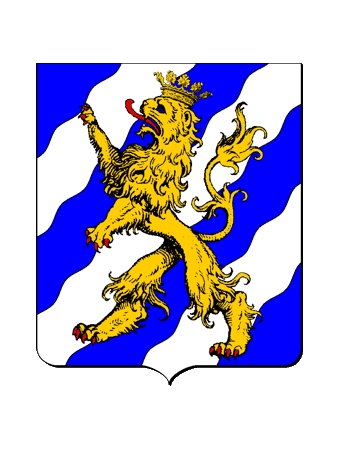
The first mention of a coat of arms with three crowns, as the coat of arms of Magnus II (1316-1374), who from 1319 was king of Sweden (until 1363) and Norway (until 1344), dates back to 1360.
In 1363, Duke Albert of Mecklenburg became king of Sweden, who approved the coat of arms with three crowns as a symbol of his kingdom. This emblem is known from the seal of the king, dated 1364. It is believed that the crowns symbolize the three regions that Sweden then consisted of: Svealand, Gotland and Osterind. 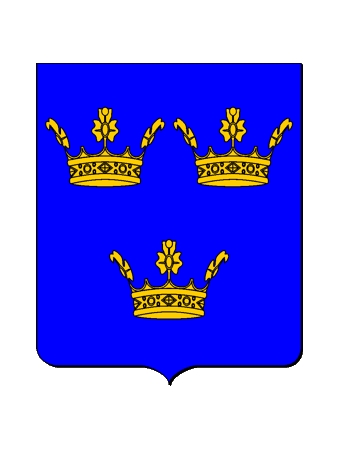
During the entry of Sweden into the Kalmar Union, its coat of arms with three crowns was an integral part of the coat of arms of the united kingdoms and the reigning monarch, in particular, King Eric XII of Pomerania (1382-1459). ![]()
After Sweden left the Kalmar Union, the king of Denmark and Norway removed the coat of arms of Sweden from his coat of arms, and the coat of arms of independent Sweden during the reign of the elected king Gustav Vasa was a four-part shield, divided by a golden clawed cross at the crosshairs of which the Vasa family coat of arms is a golden sheaf in blue and silver -red field, double beveled on the left; in the first and fourth parts - three golden crowns in a blue field, in the second and third - a rearing golden crowned lion in a blue field with three silver left bands. 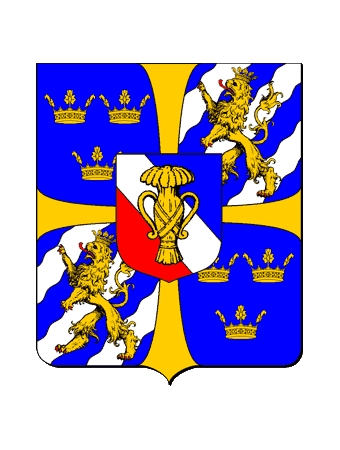
For the first time, the coat of arms, with a field divided by a four-part cross, is found on the seal of King Karl XVIII Knutsson, dated 1448.
After King Christian III of Denmark placed the Swedish crowns in his coat of arms as a reminder of the Kalmar Union, the son of Gustav Vasa, the Swedish king Eric XIV of Norway, placed three Danish lions in his coat of arms, which was the reason for the start of the Northern War (1563-1570).
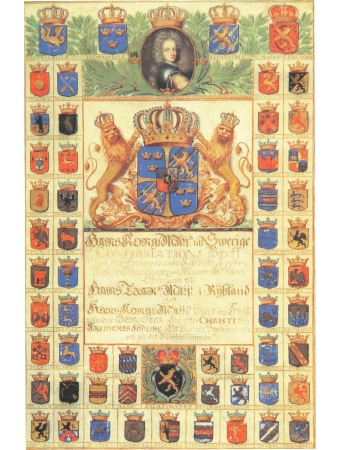
The coat of arms of Sweden and the coats of arms of its possessions during the reign of Charles XII
In 1810, Napoleonic Marshal Jean Baptiste Bernadotte (1763-1844) was elected heir to the Swedish throne, and in 1818 he was crowned King of Sweden under the name of Charles XIV Johan and became the ancestor of the royal dynasty that has been ruling in Sweden to this day.
King Charles XIV approved the new coat of arms. The field of this coat of arms is divided by a golden forked cross into three parts: in the first - the coat of arms of Sweden itself (three golden crowns in a blue field), in the second - the coat of arms of Norway (in a red field, a reared golden crowned lion of St. Olaf holding a battle ax in its paws), in the third - the coat of arms of the ancient Folkung dynasty (a reared golden crowned lion in a blue field with three silver left bands). 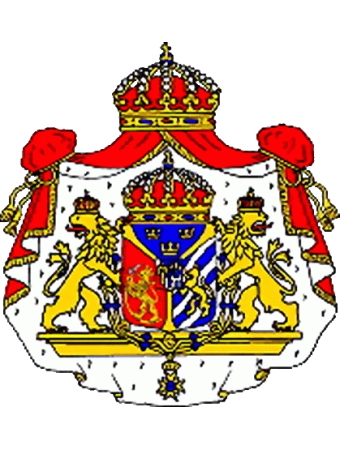
On the central shield there is a dynastic coat of arms, consisting of the coat of arms of the Vaza dynasty (a golden sheaf in a blue-silver-red field, twice beveled to the left) and the coat of arms of the new king (in a blue field above a wavy silver extremity, a silver bridge with three arches and two towers, over the bridge seven golden stars symbolizing the constellation Ursa Major, headed by Napoleon's golden eagle. 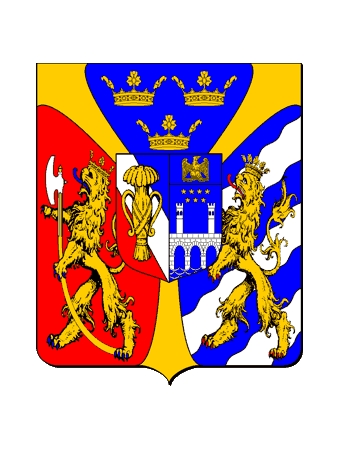
Subsequently, the shield of the coat of arms of the United Kingdoms of Sweden and Norway (1814-1905) became a four-part, quartered gold pawed cross, on which was located a shield with a dynastic coat of arms, consisting of the coat of arms of the Vasa dynasty and the coat of arms of the Bernadotte dynasty. 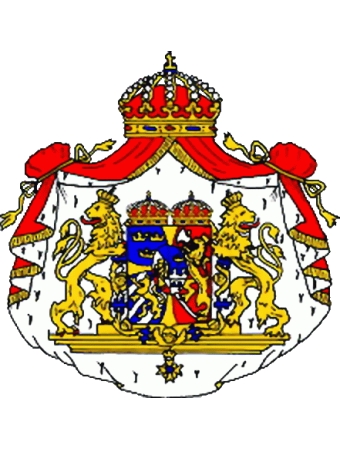
In the first quarter of the coat of arms - the coat of arms of Sweden, in the third - the coat of arms of the ancient Folkung dynasty, the second and fourth quarters were combined and here was the coat of arms of Norway.
Currently, the Kingdom of Sweden has two coats of arms - Small and Large, which were approved on May 15, 1908.
The small coat of arms is a shield crowned with a royal crown, in the blue field of which there are three golden crowns. It is used government agencies.
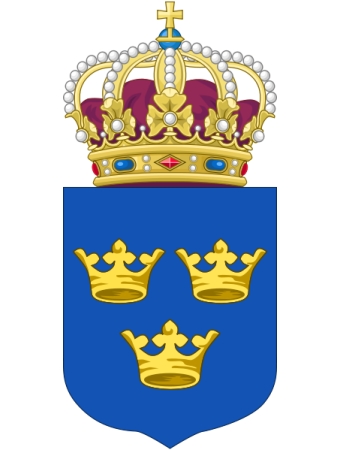
Sometimes a variant of the Small Coat of Arms is used, surrounded by a chain with the sign of the Order of the Seraphim.
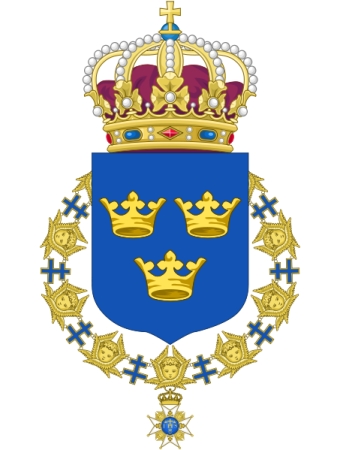
The large royal coat of arms is a shield, the field of which is divided into four parts by a golden cross. In the first and fourth - in a blue field there are three golden crowns (a small coat of arms), in the second and third - a reared golden crowned lion in a blue field with three silver left bands (dynastic coat of arms of the Folkunger family.
In the center of the shield, at the crosshairs of the cross, is the coat of arms of the Bernadotte dynasty. It is dissected: in the first field is the coat of arms of the Vaza dynasty, which ruled in 1523-1654. in the second - in blue, the golden eagle and the constellation Big Dipper, below - a bridge with two high towers. The eagle sitting on a ray of light was at the time a sign of the dignity of the prince, the bridge is a symbol of the right to the southern Italian lands, granted by Napoleon to Jean Baptiste Bernadotte in 1806, along with the Italian title of the sovereign prince of Pontecorvo. 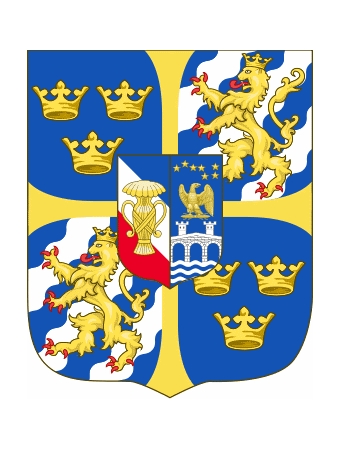
Heraldic shield
The shield of the royal coat of arms is surrounded by a chain with the sign of the Order of the Seraphim, which was established in the 13th century. King Magnus I and restored in the 18th century.
The shield holders are crowned lions, the tails of which, according to the law of May 15, 1908, are double. The mantle of the coat of arms is surmounted by a royal crown. 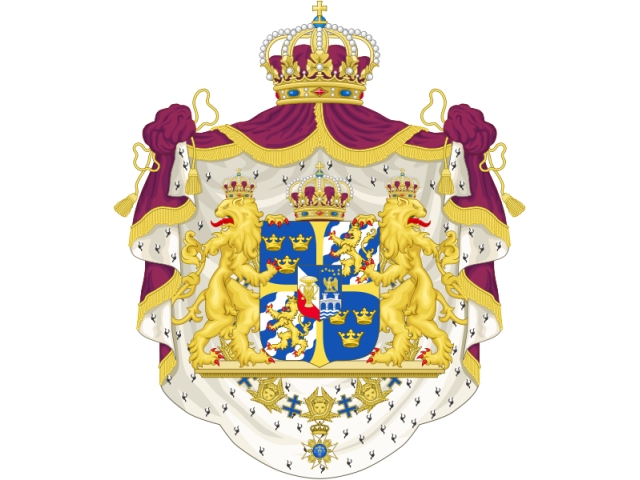
Sometimes simplified versions of the Great Royal Coat of Arms are also used: without a mantle, without shield holders, without a chain with the sign of the Order of the Seraphim. 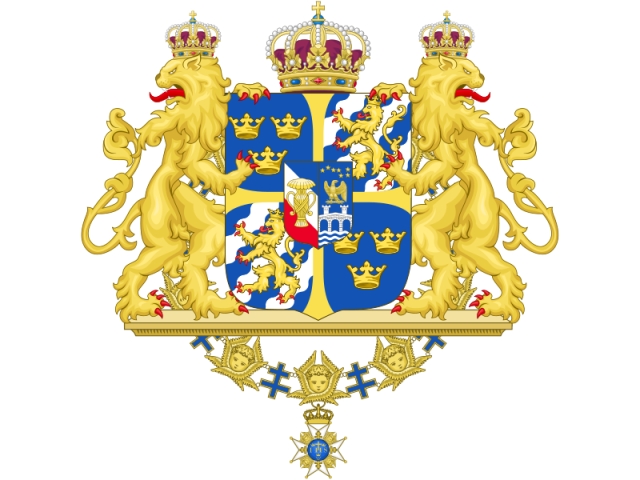
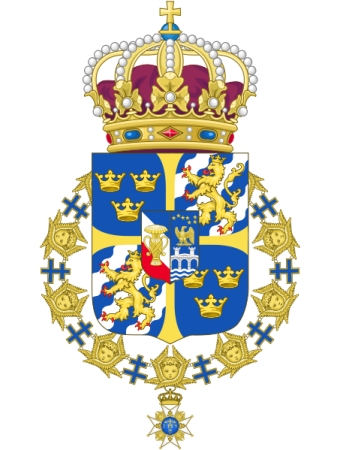
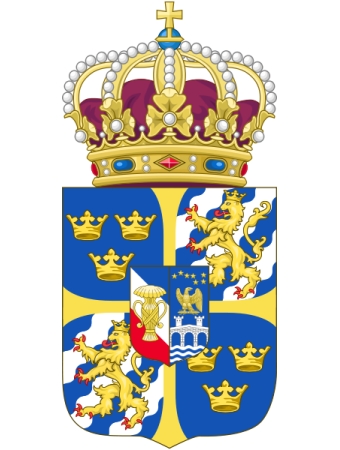
Kingdom of Sweden- a constitutional monarchy with a parliamentary form of government.
Area: 449,964 km2.
Capital: Stockholm.
Official language: Swedish.
The head of state - the king, is endowed with purely representative or ceremonial functions and is a symbol of the Swedish state and nation. supreme body legislature- riksdag. The highest body of executive power is the government.
Administrative division: 24 len.
Eric III, who can be considered the first official symbol country. In 1224, three leopards first appeared on it, which were located one above the other, which was similar to the Danish coat of arms. After the death (in 1249) of King Eric, there were no direct heirs. Jarl Birger from the noble family of the Folkungs, as the closest assistant to the late ruler, achieved the throne for his young son Valdemar, who is Eric's nephew in the female line.
Golden Lion
Jarl Binger, who ruled Sweden as his son's guardian until 1266, had on his family coat of arms the image of a golden lion on an azure background over three left silver bands. After the transfer of all power to the adult Valdemar, the new king used the coat of arms of his uncle Eric III, on which there were three lions, as his coat of arms. In 1225, Valdemar's brother Margus Birger overthrew him from the throne, earning him the nickname Protector of the Peasants. He, unlike his predecessor, decided to remain committed to the family heraldry of the Folkung family, but crowned lions appeared on the new coat of arms.
Three crowns
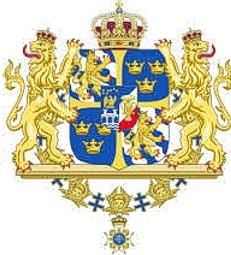
The three golden crowns are the most famous feature around the world, by which the coat of arms of Sweden is recognized. What does this heraldic element mean and what is its purpose? Disputes about this do not stop to this day, and various hypotheses are put forward. Interestingly, crowns are found on the oldest known royal seal. Three crowns as one of the main elements of the coat of arms were introduced by King Albert of Mecklenburg (1363-1389). One of the versions connects the appearance of these details on the coat of arms with the most widespread at that time cult of the Three Kings - the Magi, who brought gifts to the infant Christ. This cult gained strength and spread after Frederick Barabarossa transferred the relics of the Magi from Milan to Cologne in 1164. The second version refers the three crowns to the symbol of the Holy Trinity.
There are versions that treat crowns as an ordinary heraldic element. Some researchers argue that they look like the crown of the Mecklenburg family coat of arms, reinforced with a sacred number, or they are signs of ownership of Mecklenburg, Finland and Sweden. Another version says that the crowns are nothing more than the coat of arms of the legendary holy knighthood embodying everything, or simply one of the coats of arms of the kings of Ancient Ireland.
The national emblem of Sweden is used as the main symbol of the state. In certain cases, a large state coat of arms is necessary when holding official events in parliament and government, the army and foreign Swedish diplomatic missions.
Great coat of arms
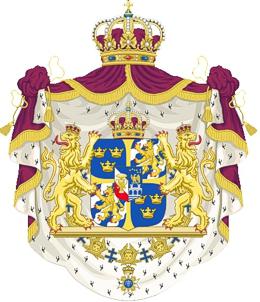
The large state emblem of Sweden can be used as the basis of personal coats of arms by members. All changes and additions regarding the main symbol of the country are approved only by the head of state.
The large state emblem is an azure-colored shield divided by a golden cross into four parts with the coat of arms of the royal house in the middle.
On the first and fourth parts of the shield are three open golden crowns (two above and one below). The second and fourth parts of the shield include six left silver and azure bevels and a crowned golden lion surrounded by scarlet.
The central shield is divided into four parts. In the first - the coat of arms of the house of Vase: two right silver and azure bevels and a golden sheaf on a scarlet field. The coat of arms of the Bernadotte family is depicted on the second part of the shield: a silver three-arched suspension bridge with two towers, on which there is an eagle holding golden thunderbolts in its paws, on top -
The shield is held in the paws by two crowned guarding lions with scarlet weapons and forked tails. The lions stand on a golden base. At the top of the shield is a royal crown, surrounded by the signs of the Seraphim.
The large coat of arms of Sweden uses a purple robe on an ermine as a background, with gold tassels, cords and fringe.
There is a simplified version of the large coat of arms, on which there are no orders, lions-shield-holders, a mantle and a base.
Small coat of arms
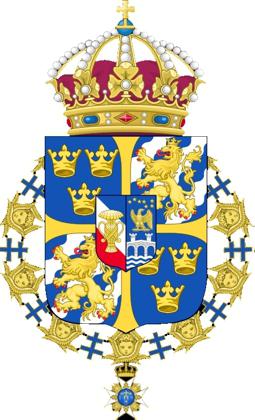 The Small State Emblem of Sweden consists of an azure-colored shield with a royal crown at the top and three open golden crowns (two on top of one). Additionally, the shield can be surrounded around the perimeter with the order signs of the Seraphim.
The Small State Emblem of Sweden consists of an azure-colored shield with a royal crown at the top and three open golden crowns (two on top of one). Additionally, the shield can be surrounded around the perimeter with the order signs of the Seraphim.
The open three gold crowns without the royal crown and shield are a simplified small coat of arms of Sweden. A photo of the hockey team of this country, where such a small coat of arms is depicted on the players' sweaters, made the three crowns one of the most recognizable symbols of the world.
Swedish organizations and companies wishing to use elements of the state emblem in their symbols are required to obtain special permission from the State Heraldic Council for this.
The coat of arms of Sweden is officially in several versions.
The shield is divided into four fields. In the first and fourth (upper right and lower left) fields there are three Swedish royal crowns. Three crowns on a blue field appeared in Sweden in the 14th century under King Albrecht of Mecklenburg. The second and third (upper left and lower right) fields depict the traditional lion of the Folkung dynasty. The small shield in the middle is the coat of arms of the Bernadodt dynasty.
The shield is supported by two lions with forked tails, on their heads the Swedish royal crown. The muzzles of the lions are turned away from the shield. The lion for many years remained an element of Swedish heraldry, and in particular the state emblem.
The shield may be decorated with royal orders. The large coat of arms is always decorated with the Order of Seraphim of Sarof - the highest state award in Sweden.
Unlike the small coat of arms, which can only be surrounded by the Order of the Seraphim, the great coat of arms can be surrounded by all or any of the four royal orders. All are used more often - the North Star, the Vase and the Sword. The Order of Charles XIII may also surround the shield.
The use of coats of arms in Sweden is regulated by law 1970:498. The coat of arms cannot be used in trademarks, signs, logos, texts, references.
The small coat of arms is used in the activities of the Government of Sweden and its agencies. Used on Swedish police uniforms.
The small coat of arms can be used in two forms:
Small coat of arms with the Order of Seraphim of Sarof.
Small coat of arms without the Order.
On the coats of arms of Sweden, the three crowns are interpreted in different ways:
- The crowns symbolize the three gods of Uppsala.
- They symbolize the three regions of Uppland.
- They are symbols of the Three Wise Men.
The coat of arms with three crowns was first used on the seal of the Swedish ruler in 1364 (originally Albert was the Duke of Mecklenburg).
The Greater Coat of Arms is used in four forms
Large coat of arms with mantle
Large coat of arms without mantle
The large coat of arms is also the personal coat of arms of the king of the country. It was developed in the 15th century.
The large coat of arms combines the coat of arms of the House of Folkungs, the coat of arms of the House of Bernadotte, the small coat of arms of Sweden with three crowns.
Historical emblems of Sweden
It should be noted that leopards were originally depicted on the coat of arms. Later they were replaced by lions. Three crowns on the heads of leopards, and later lions, according to some heraldists and historians, could symbolize three kingdoms: Norway, Sweden, Skane (modern south of Sweden).




